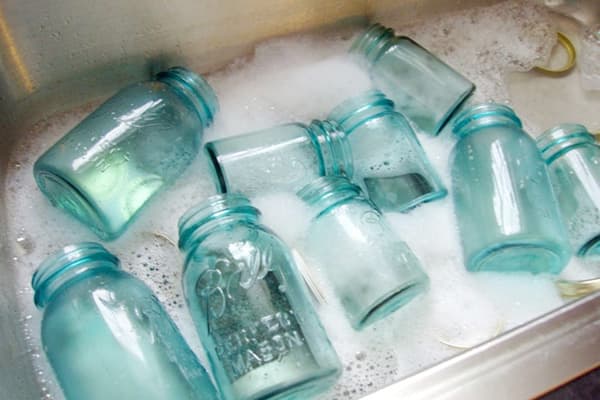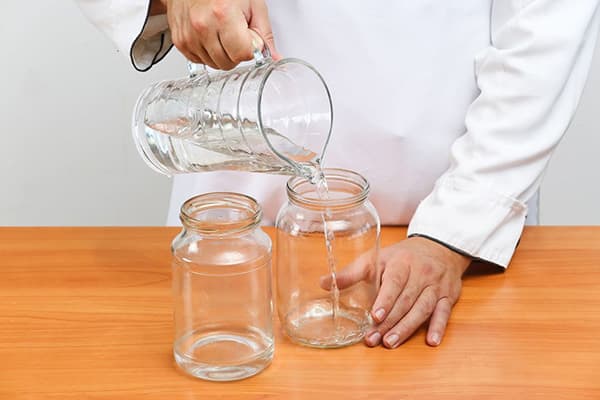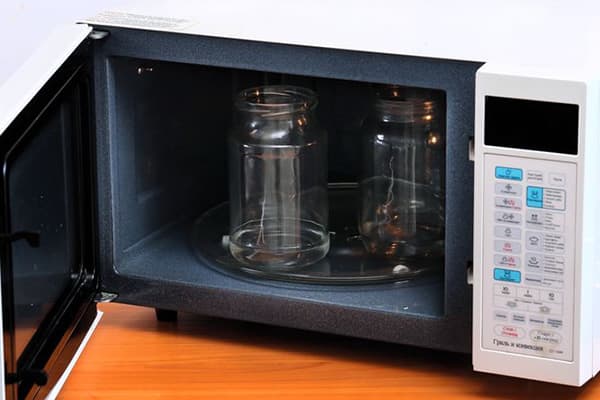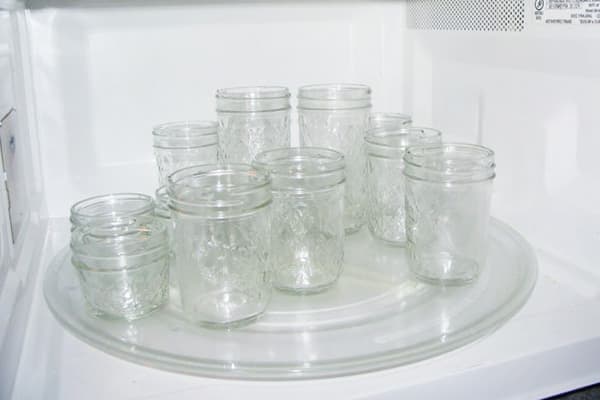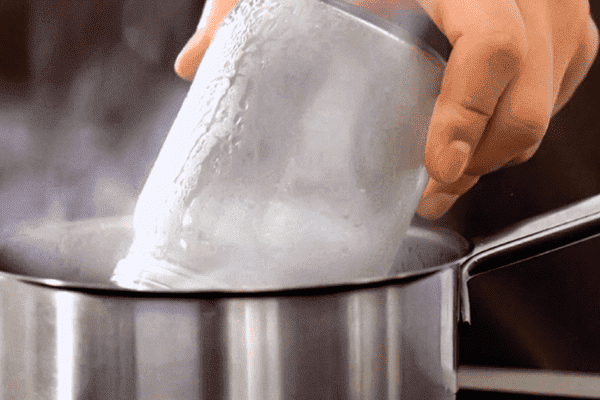Sterilization of cans in the microwave: how to prepare containers for seaming in 5 minutes?
Content:
An important stage in the preparation of canned food for the winter is the disinfection of dishes in a pot of boiling water. Is it possible to sterilize cans in the microwave, spending less time and effort? Fortunately, yes. If you follow the correct procedure and precautions, nothing will happen to the container. After all, the microwave was originally intended for heating food in various dishes, including glass.
Glass jar preparation
If the jars are not properly prepared for sterilization, the glass may burst and ruin the microwave. Then it will take a long time to pull out the fragments. Inspect the dishes for cracks, rough chips, dents, scratches, or bumps.
If the jars have maintained their integrity, they must be thoroughly washed with warm water using baking soda. Flavored detergents are not suitable. Particles of soap and chemical additives should not accidentally end up in foods. Make sure that there are no stains from baking soda on the bottom and walls of the cans.
Then glassware should be dried on a clean towel.
The lids are sterilized separately from the cans in the classic way - in a pot of boiling water. Do not heat metal objects in a microwave oven.
You can sterilize jars in the microwave when the dishes sparkle with cleanliness.
Sterilization process
The easiest way to disinfect cans is by exposing them to high temperature water vapor. It completely envelops the glass containers from the inside, destroying bacteria, fungi and viruses.
The sequence of actions is as follows:
- It is necessary to pour clean water into the jars so that the bottom is covered by 3 centimeters. It is advisable to take distilled or settled liquid so that no metal precipitate forms on the container during sterilization.
- Put the cans on the tray of the microwave oven. Make sure that they do not touch each other's walls.
- Microwave a power of 800 watts and press the start button.
How long to sterilize glassware? It depends on the degree of utilization of the microwave oven and the volume of containers. 3-4 half-liter cans are enough to withstand 3 minutes.
A 3-liter jar is sterilized for 4-5 minutes, after pouring half a mug of water into it and laying it on the pallet sideways so that the liquid does not leak.
Dry sterilization
Allows you to process cans using not only hot water vapor, but also microwave. The dry sterilization method has a minus - a higher risk of damage to glass containers.
A feature of the microwave oven is that its rays affect only wet objects. You may have noticed an interesting paradox before: the liquid in the preheated soup is hot, and the slices of meat and vegetables are cold. The more moisture the product contains, the faster it warms up. Therefore, even with the dry sterilization method, containers with water are placed inside the microwave.
What should be done?
- Put in the center of the pan of the microwave oven a mug filled with clean water by 70%. If you pour more liquid, it will spill down after boiling.
- Around the mug place empty cans.
- Set the microwave power to 700 watts, and the timer for 5 minutes.
- Press the start button.
Some housewives claim that they sterilize the cans completely dry and the glass containers do not deteriorate. However, they do not know that they risk incapacitating the appliance itself.
How to get cans and go to the conservation of products?
So, the microwave timer squeaked, signaling the end of the sterilization process. Since the cans became very hot, they need to be taken out with a tack, mittens or a towel.
Do not take dishes by the neck. After sterilization, hot cans become fragile, so you need to get them with both hands, clutching the walls. The towel should be dry and warm. The slightest temperature difference will cause the jar to burst, and hot fragments will fly into you. Be careful.
If you sterilized the container in a wet manner, allow it to dry before preservation. Prepare a clean towel. Put the cans on it sideways. So the dishes will dry faster than if you put it on the towel with the neck down.
After 15-20 minutes, the cans are ready. They are ideal for rolling jam, vegetables, mushrooms or meat stews.
How to sterilize dishes with blanks?
Most often, bacteria are contained in the products themselves, intended for conservation. Even if you roll meat, vegetables and berries in a sterilized glass jar, there remains a risk of multiplication inside the pathogens, their release of waste products - toxins.
Consider how to protect yourself from food poisoning in the future.
Jam preserves:
- Fill a clean, dry jar with jam at 80%. No more pouring, otherwise a sweet sticky mass will spill onto the pallet.
- Set the power to 800 watts, the time - 6 minutes.
- Press the start button.
- After the timer beep, leave the jar of jam in the microwave for another 5 minutes. During this time, boil the metal lids in a pan with water.
- Remove the glass dishes with the treat from the microwave and roll up the lids.
Harvesting salted vegetables and salads:
- Take two clean liter cans and fill them with 50% content.
- Put the container in the microwave. Make sure that the glass walls do not touch each other.
- Set the power of the waves to 800 watts, and the timer for 3 minutes.
- Turn on the microwave.
- After the timer beeps, leave the workpieces inside the microwave oven for another 6 minutes. Sterilize the covers and plug during this time.
- Gently remove the pickled jars from the microwave. Using a clean fork, transfer vegetables (salad) from one sterilized glass jar to another. Roll food lids.
Why is microwave sterilization better than traditional boiling?
Often, simplified ways of doing ordinary household chores cause people to distrust just because they are new. Some housewives still sterilize containers "the old fashioned way", even though they have a microwave oven at home. But in vain.
Microwave sterilization of cans has a number of advantages compared to conventional boiling:
- saves time;
- safe because housewives do not need to contact boiling water;
- bacteria and fungi are additionally affected by microwave rays;
- It maintains a pleasant microclimate in the kitchen: homemade ones no longer choke on hot water vapor.
Perhaps the only negative is the energy consumption. But if the hostess needs to roll up 2-3 jars of jam, she will not even notice the increase in cash costs for electricity.
